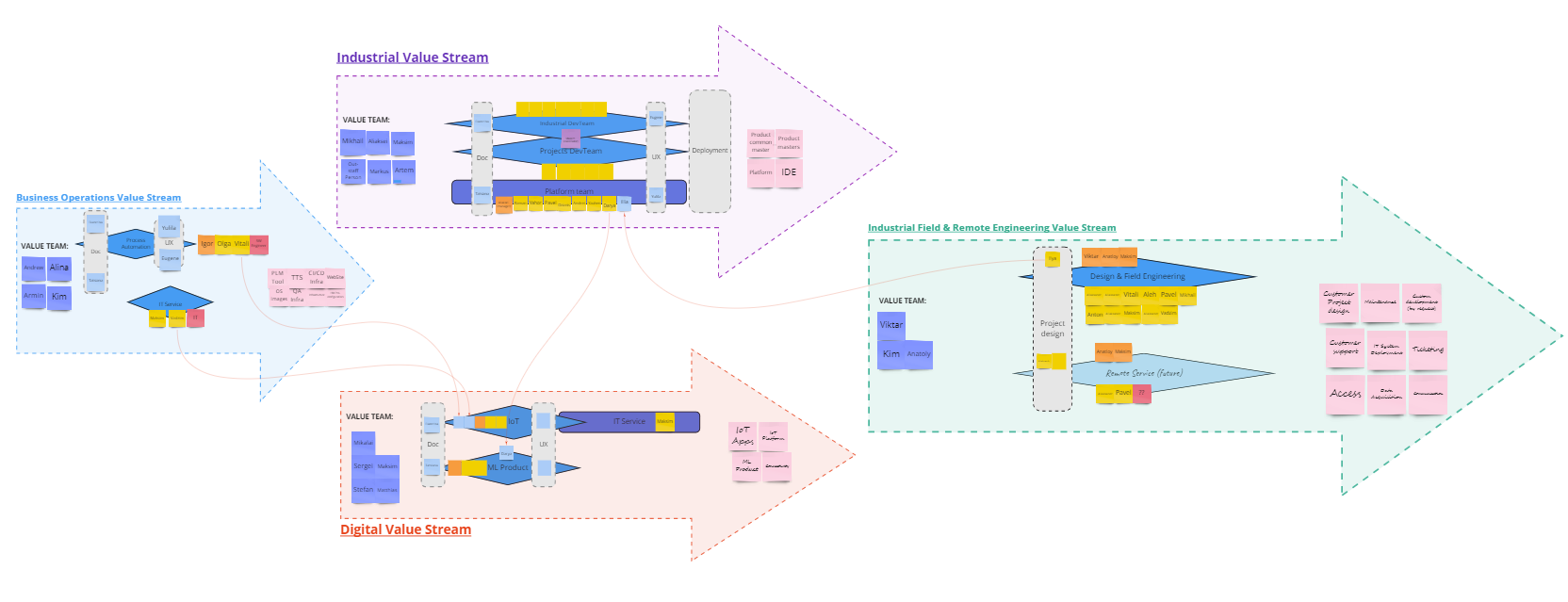Case study interview: SAFe implementation in Atotech
Case study interview: SAFe implementation in Atotech
Atotech (international speciality chemical and equipment company)

Atotech is a leading speciality chemical technology brand that delivers chemicals, equipment, software, and services to support diverse end markets. These include smartphones and other consumer electronics, communication infrastructure, and the computing sector. On top of that, they provide a number of industrial and consumer applications for cars, heavy machinery, and household appliances.
Here is a story of a SAFe transformation as told by its key participants - Artem Milevsky (Agile Coach), Maxim Lapo (Head of Engineering), and Nikolay Kuchuk (Head of Product).
Here is a story of a SAFe transformation as told by its key participants - Artem Milevsky (Agile Coach), Maxim Lapo (Head of Engineering), and Nikolay Kuchuk (Head of Product).

Value Stream Identification Workshop results
We face a great number of challenges in our industry every day in this rapidly changing world. We need to gain and develop new organizational "skills" to remain relevant: adaptability, solution delivery speed, and staying customer-centric.
There was a tipping point that we reached three years ago when we realized we needed Agile–a mindset that let us hit our main pain points: decision-making, team alignment, collaboration, and outcome delivery.
Our Business Agility transformation started in Q3 2019, when our Digital Solutions function, IT, and other teams embraced that Agile mindset.
Every day, our engineers and management faced work culture and process issues that made us slow, unpredictable, and non-customer-centric.
There was a tipping point that we reached three years ago when we realized we needed Agile–a mindset that let us hit our main pain points: decision-making, team alignment, collaboration, and outcome delivery.
Our Business Agility transformation started in Q3 2019, when our Digital Solutions function, IT, and other teams embraced that Agile mindset.
Every day, our engineers and management faced work culture and process issues that made us slow, unpredictable, and non-customer-centric.

Program Board
The most painful ones we came across were:
For three years, we tried to fix this by applying and experimenting with the Scrum framework and the Kanban method in small isolated engineering team environments. This was our first failure! Together with our Leadership team, we looked over our results and figured out that we needed to change our perspective on the whole transformation process.
- Rules and procedures took priority over quick decisions and a short business value delivery cycle.
- Tactics prevailed over strategy: the IT side always took a reactive approach to value creation. Instead of suggesting solutions to known and clear strategic initiatives proactively, our engineering teams waited for detailed business requirement documentation before doing anything.
- Despite numerous cross-team dependencies, teams preferred to work on their tasks as if they were completely isolated from the rest of the company. This meant that we had a problem with hitting common goals.
- There were no customer or stakeholder feedback loops defined at all.
- Mistakes came at a high cost because our solution quality was unpredictable.
- Stakeholders were seen as “evil bosses” and engineers as “oppressed laborers”, instead of having a healthy cooperative relationship. Because of this, teams wasted time on accusations and excuses, instead of collaborating on looking for the best possible solutions.
For three years, we tried to fix this by applying and experimenting with the Scrum framework and the Kanban method in small isolated engineering team environments. This was our first failure! Together with our Leadership team, we looked over our results and figured out that we needed to change our perspective on the whole transformation process.

PI Planning Teams Boards
So, we decided to go SAFe! With its transformation principles and core values firmly in our hearts, the new chapter in our organization began!
On our journey to SAFe, we have so far:
● Trained more than 70+ people in our Digital Solutions Division.
● Identified, staffed and launched two Agile Release Trains of four Value Streams.
● Introduced shared UX and post-documentation teams.
● Implemented a PI Planning event as our new customer value-oriented structure's heartbeat.
● Transitioned from silos to team-based networks in our organizational structure.
● Defined new roles and chartered the team and Agile Release Train design.
● Introduced relative estimation to be done by the whole team.
● Run centers of excellence: Quality Assurance, Agile, DevOps, Automation Engineering, and Product Engineering.
● Moved from detailed documents to minimal drafts and stories as requirements.
On our journey to SAFe, we have so far:
● Trained more than 70+ people in our Digital Solutions Division.
● Identified, staffed and launched two Agile Release Trains of four Value Streams.
● Introduced shared UX and post-documentation teams.
● Implemented a PI Planning event as our new customer value-oriented structure's heartbeat.
● Transitioned from silos to team-based networks in our organizational structure.
● Defined new roles and chartered the team and Agile Release Train design.
● Introduced relative estimation to be done by the whole team.
● Run centers of excellence: Quality Assurance, Agile, DevOps, Automation Engineering, and Product Engineering.
● Moved from detailed documents to minimal drafts and stories as requirements.

Inspect & Adapt Workshop
Our results:
● Stakeholders involved in the SDLC appreciate the chance to provide feedback early on in the process, instead of at the very end, when feedback is the least valuable.
● Teams have reached 90% commitment fulfilment on each PI.
● We now have a culture of allocating dedicated time and effort to exploring new practices or proving the teams' own hypotheses.
● Clear and measurable (and measured on a regular basis) outcomes from each Value Stream became a useful tool in stakeholder expectation management.
● Decisions are made based on the teams' and ARTs' process metrics (flow, Agile maturity, and quality).
● The introduction of Inspect and Adapt cycles made complex and systematic issues stand out.
● Transparency and alignment increased drastically on every level. All dependencies, milestones and objectives are communicated through the Program Board and are available to all parties, including IT, Product Engineering, Business Development, Marketing, and Contact Center.
● Through the System Demo event, stakeholders and suppliers can directly affect the product vision and development plans by providing timely and constructive feedback.
● Finally, employee engagement has substantially increased, and we are witnessing 70% growth in product collaboration. We made team members understand the value of the features they were working on. By providing regular synchronization, clear business context, and transparent goals at every level, we have unleashed the creative power of our teams.
And this is not the end of our journey! We will continue to focus on these basics, core values, and principles, which have become part of our division's culture and norms. We are actively spreading it all across our entire organization!
● Stakeholders involved in the SDLC appreciate the chance to provide feedback early on in the process, instead of at the very end, when feedback is the least valuable.
● Teams have reached 90% commitment fulfilment on each PI.
● We now have a culture of allocating dedicated time and effort to exploring new practices or proving the teams' own hypotheses.
● Clear and measurable (and measured on a regular basis) outcomes from each Value Stream became a useful tool in stakeholder expectation management.
● Decisions are made based on the teams' and ARTs' process metrics (flow, Agile maturity, and quality).
● The introduction of Inspect and Adapt cycles made complex and systematic issues stand out.
● Transparency and alignment increased drastically on every level. All dependencies, milestones and objectives are communicated through the Program Board and are available to all parties, including IT, Product Engineering, Business Development, Marketing, and Contact Center.
● Through the System Demo event, stakeholders and suppliers can directly affect the product vision and development plans by providing timely and constructive feedback.
● Finally, employee engagement has substantially increased, and we are witnessing 70% growth in product collaboration. We made team members understand the value of the features they were working on. By providing regular synchronization, clear business context, and transparent goals at every level, we have unleashed the creative power of our teams.
And this is not the end of our journey! We will continue to focus on these basics, core values, and principles, which have become part of our division's culture and norms. We are actively spreading it all across our entire organization!
Is this the right case for you?
Write to us, we will contact you and tell you how this approach is applicable in your situation.
Might be interesting



